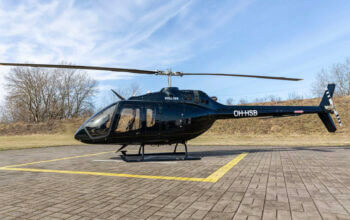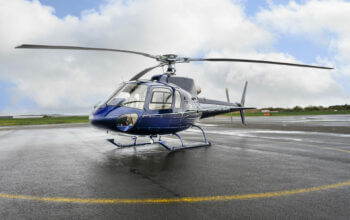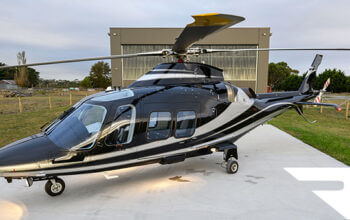Estimated reading time 8 minutes, 11 seconds.
Twenty years ago, the prototype Bombardier Global Express made its maiden flight on Oct. 13, 1996, from Runway 33 at Downsview Airport in Toronto.

Conceived as a luxurious long-range business jet, the development of the Global Express proved to be a wise and profitable decision for Bombardier Aerospace, which has delivered more than 730 aircraft worth over $35 billion at list prices
Now, Bombardier engineers and test pilots at Downsview are preparing the prototype ultra long-range Global 7000 for its first flight from the company’s private 7,003-foot runway in central Toronto.
If the engineers can meet the sales team’s desires, the first Global 7000 will probably roar into the sky around the time that potential customers will be converging in Orlando, Fla., for the National Business Aviation Association (NBAA) convention, Nov. 1 to 3, 2016.
Twenty years ago, the roll-out of the Global Express was a high-profile international event with 2,500 guests invited to Bay 9 of the de Havilland factory on Aug. 26, 1996.
This time around, publicity about the roll-out of Flight Test Vehicle No 1 (C-GLBO) in late August was a non-event, and the first “power on” tests during the past few weeks were barely noticed.
Bombardier has had its hands full certifying and delivering the first C Series commercial jets, but now the spotlight is about to shift to the Global 7000. Entry into service is targeted for the second half of 2018, when the US$72.8 million Global 7000 will become one of Canada’s most expensive and prestigious exports.
Bombardier fully expects the Global 7000 (and its longer range Global 8000 derivative) to capture a 35 to 40 per cent share of the predicted $130 billion market for 2,300 large business jets over the next 10 years.
Going Global
On Oct. 28, 1991, Bombardier announced ‘Project Global Express’ — its first clean sheet aircraft design — during a lavish party at the Houston Museum of Natural Science during the NBAA convention.
The Global Express was designed to “leapfrog” the Gulfstream IV in speed, range and cabin comfort, positioning Bombardier at the top of the business aviation food chain with a cabin that was wider and taller than its competitors.
Bombardier entered the aerospace industry in 1986 when it bought Canadair from the Canadian government, then Short Brothers in Northern Ireland in 1989 and Wichita’s Learjet in 1990.
In May 1991, Bombardier rolled out the prototype Canadair Regional Jet (CRJ) at its new factory at Dorval (Trudeau) Airport in Montreal. And then a few months after NBAA 1991, Bombardier (with the Government of Ontario) bought Boeing’s ailing de Havilland division in Toronto.
The race between business jet makers was heating up. Gulfstream Aerospace launched the Gulfstream V in 1992. And Bombardier secured enough orders to launch the Global Express in December 1993.
The Global Express combined the forward fuselage of the Canadair Challenger and Regional Jet with a completely new wing, centre section, tail and engines. The goal was a high performance aircraft that could fly eight passengers 6,500 nautical miles in luxurious comfort–a distance equivalent to New York to Tokyo–at Mach 0.85.
The Global Express proved to be transformative for Bombardier and the Canadian aerospace industry. It was the second Bombardier aircraft program (after the Learjet 45) and the first clean sheet design to utilize the combined talent pool of Canadair, Shorts, de Havilland and Learjet.
Canadair built the Global Express cockpit; Shorts the forward fuselage, horizontal stabilizer and engine nacelles; de Havilland the rear fuselage with responsibility for final assembly; and Learjet in Wichita was the home of the Bombardier Flight Test Centre.
The Global Express was one of the world’s first aircraft programs where a team of international risk-sharing partners were responsible for delivering fully integrated aircraft systems to the final assembly line.
Mitsubishi Heavy Industries (MHI) of Japan built the wing and centre section; Messier Dowty in Ajax, Ont., the landing gear; Sextant in France the primary and secondary flight controls; Honeywell supplied the cockpit avionics; and Rolls Royce BMW (now Rolls Royce Deutschland) the BR710 turbofan engines.
Locating the final assembly line in Toronto diversified the business base of the Downsview factory, which had lost money under Boeing’s stewardship when it only built regional aircraft.
The Global Express was certified by Transport Canada on July 31, 1998, customer deliveries began in early 1999, and the Global XRS was introduced in 2005 with an upgraded cockpit and cabin.
The Global 5000 – a truncated Global Express – first flew at Downsview on March 7, 2003. It was designed to sell at a lower price point (US$33.5 million equipped) and was certified on March 12, 2004.
Upgraded models of both aircraft were certified in 2011 with the Global Vision Flight Deck (featuring a Rockwell Collins Pro Line Fusion avionics suite) and were rebranded as the Global 5000 and Global 6000.
Global deliveries averaged about three aircraft per month between 1991 and 2001, nosedived to 14 deliveries in 2003, then began a steady climb to a remarkable 80 aircraft deliveries in 2014, before an economic slowdown in emerging markets triggered a reduction in production to the current rate of less than 50 aircraft a year. Aircraft were delivered “green,” with most of them flown to Dorval for completion in-house by Bombardier, which bought Innotech Aviation’s completions business in late 1996.
Air Combat
In 2005, Gulfstream commenced development of a new top of the line business jet, unveiling the G650 program in March 2008. The aircraft featured a new cabin, wing, fly-by-wire flight controls and a 7,000 nautical mile-plus range.
Bombardier announced the new Global 7000 and Global 8000 at the 2010 NBAA convention in Atlanta, offering customers an “unprecedented combination” of comfort, performance and flexibility.
The Global 7000 has been designed with a large spacious cabin featuring four unique “living spaces” and a dedicated crew rest area. It will incorporate the latest technologies such as a new high-speed transonic wing optimized for short field performance and exceptionally long range, the Bombardier Vision Flight Deck, a new fly-by-wire control system with sidestick, and powerful new 16,500-pound thrust GE Passport turbofan engines.
When Bombardier announced the aircraft in 2010, its goal was to set the benchmark for a new category of large business jets offering 20 per cent more living space than any competitors.
To this end, the Global 7000 has the largest cabin in its class (54 feet 7 inches/16.64 metres), a maximum speed of Mach 0.925 and a range of 7,400 nautical miles at Mach 0.85 (with eight passengers and four crew).
The Global 8000 will have a range of 7,900 nautical miles and three “living spaces” in a shorter 45 ft. 7 in. (13.89 metres) long cabin, nine feet less than the Global 7000.
Bombardier lined up a new set of aerospace partners to build the Global 7000/8000. The wings are made in Texas by Triumph Aerospace; the fuselage in Mirabel, Que., by STELIA North America Assembly and Systems Integration (formerly Aerolia Canada); and Bombardier makes the Global cockpit in Montreal and the new tail and empennage in Querétaro, Mexico.
The Global 7000’s entry into service was pushed back two years from 2016 to 2018 as Bombardier struggled to finance three new aircraft programs (C Series, Global 7000/8000 and the now-cancelled Learjet 85). The Global 7000 also required some unspecified changes to its wing.
Gulfstream has had the top end of the corporate market to itself since it delivered its first G650 in late 2012.
Now it is Bombardier’s turn to strive for corporate air supremacy as the first Global 7000 rockets off the ground.








